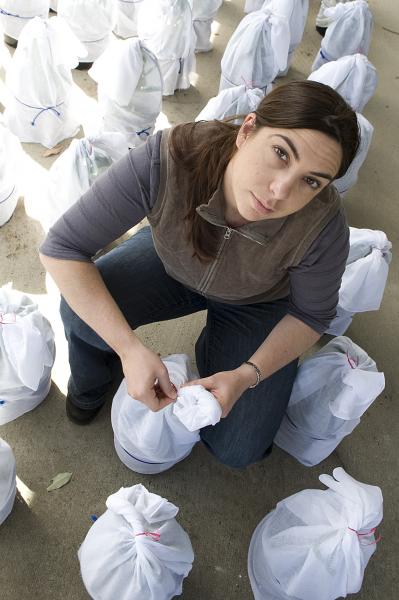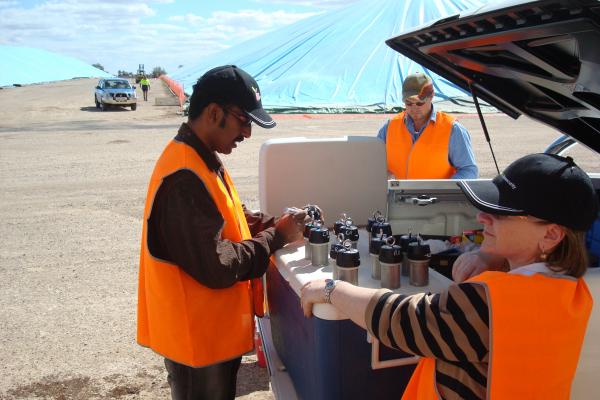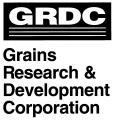Complete
This project will assess the toxicity of reduced risk insecticides against a range of commercially available biocontrol agents for use in integrated pest management programs by the horticultural industry.
What is the biosecurity problem?
If exotic pests become established in Australia, it may be possible to initially base IPM on biocontrol agents available in Australia.
The outputs of this reasearch are to:
- assess new reduced risk insecticides which are being produced for the Horticulture Industry for the control of Lepidoptera, Coleoptera, Diptera, and Aphids. For example, the insecticide Spirotetramat is proposed for control of aphids, cicadas, grape louse, whitefly, cottony cushion scale and mealy bug in a range of horticultural crops. Whilst the efficacy of these pesticides is being evaluated against existing pests, not much is known of their potential impact (direct and indirect) on biocontrol agents, and
- identify and monitor existing naturally occurring biocontrol agents (sticky traps, plant samples) to obtain information on their phenology, spatial distribution and abundance in two horticultural crops.
Who will be the end-users of this research?
- The horticultural industry.

Jessica Harrison doing trials in the field.
STUDENT

Jessica Harrison
Student CRC60122: Assessment of the toxicity of reduced risk insecticides (Hons)
Read More
PROJECT DETAILS
Complete
Supervisor
Dr Sonya Broughton (DAFWA), Prof Jonathan Majer (Curtin University)
Supervising Institution
Curtin University
Term
January 2008 - November 2008
LOCATION
Flat grain beetle (FGB) is a major emergency plant pest (EPP) of stored grain in Australia. Populations of FGB have recently developed high level resistance to phosphine (the only viable fumigant available for non-quarantine use) resulting in control failures with current dosage regimes.
As there is no practical alternative to phosphine, failure to control FGB with phosphine places at risk market access for Australian grain worth up to $7 billion in annual trade. Therefore there is an urgent need to develop appropriate phosphine fumigation protocols to eradicate outbreaks of strongly resistant FGB.
Research outcomes:
- Characterisation of high resistance to phosphine in flat grain beetles (FGB) for the first time internationally.
- Establishment of fumigation protocols and an eradication strategy that will enable industry to eradicate infestations of phosphine-resistant flat grain beetle and prevent or delay further selection for resistance to phosphine.
- Development of a rapid test to detect highly resistant FGB.
- Facilitate continued market access of Australian grain.
Research implications:
The success of Australia’s $7 billion grain industry depends on the maintenance of high standard in its post-harvest produce through effective pest management. The absence of detectable levels of insect infestation is such an important issue to world grain markets that to maintain its competitiveness in premium markets, Australia guarantees supply of an insect-free product. This strategy is enforced by Australian Quarantine and Inspection Service (AQIS) through the Exports (Grain) Regulation that specifies a ‘nil tolerance for live insects’ on all grain leaving the country. Nil tolerance for live insects is also the standard generally adopted by domestic buyers of grain.
The most cost-effective method to meet the Exports (Grain) Regulation is the application of chemicals to grain. Currently, the industry relies on a single fumigant, phosphine, because of an increasing sensitivity of grain markets to the presence of pesticide residues, the development of insecticide resistance to other chemical alternatives and the lack of practical alternatives. Phosphine has the enviable reputation for being relatively cheap, accepted as a residue-free treatment internationally and having flexibility in its application. Traditionally, the grain industry has managed resistance essentially by replacing redundant chemicals with new materials. Chemical treatments are favoured because available non-chemical methods, on the whole, are either significantly more expensive, less versatile, do not easily match grain-handling logistics, are less effective or require significant capital investment. Therefore, the chemical replacement strategy is no longer viable and at least for the medium term, the Australian grain industry will need to rely on phosphine for disinfestations of its stored commodities to meet the market demands.
The CRCNPB-supported FGB fumigation protocol development project has delivered two new fumigation protocols that can control highly resistant FGB populations. In addition, an eradication strategy has now been deployed that will eradicate infestations of phosphine-resistant FGB and prevent or delay further selection for resistance to phosphine and restrict their spread.
A direct implication of the research finding is that by extending the life of the effective use of phosphine, industry will avoid the use of contact pesticides for the time being. This will in turn avoid potential trade issues and save the industry from significant economic loss.
An independent cost-benefit analysis for this project by GRDC (Ross McLeod) has suggested that even if there are significant changes to key variables such as costs of fumigation, probability of success and volumes of grain treated with contact insecticide, prolonging the life of phosphine through development of new protocols will still result in substantial economic benefits.
Acknowledgements:
The research team expresses sincere thanks to farmers and the managers and field staff of GrainCorp, CBH and Viterra for their support and help for accessing storage sites for collection of insect samples and undertaking field trials. The team would also like to thank GRDC for their support throughout the research.
PROJECT LEADER

Dr Manoj Nayak
Project Leader CRC50098: Fumigation Protocols for Flat Grain Beetles
manoj.nayak@deedi.qld.gov.au
Phone: 07 3896 9431
Fax: 07 3896 9446
Read More
PROJECT DETAILS
Complete
Term
July 2008 – December 2009
PROGRAM DETAILS
LOCATION
CORE CRC PARTICIPANTS
A range of naturalised harmful plant storage pests including beetles, psocids, moths and mites habitually threaten the food safety, market access, trade and the overall profitability and sustainability of the Australian grain industry. Some of these pests have already been detected with resistance to phosphine and the spread of resistance is on the rise annually. In addition, new resistances are also being developed, a recent example being the detection of strong resistance to phosphine in several populations of flat grain beetles.
There is a need for a robust and systematic national resistance monitoring program to provide both strategic and tactical information on the presence/absence and trends in resistance to phosphine to underpin resistance management in the grain industry and to aid in the identification of factors that affect the risk of resistance in the system.
Research outcomes:
- establishment of a robust sampling protocol to monitor resistance to phosphine and grain protectants in stored grain pests
- standardised national assay methodology for detection of resistance to phosphine
- efficient, effective and comprehensive national data collection and analysis system established using the Australian Grain Insect resistance database.
- established that resistance to phosphine is mediated by the same genes across Australia in major pest species
- established that current impregnated paper assay for resistance to key grain protectants in major storage pests accurately reflects the resistance to respective field application rates
- provided early warning of emergence of strong resistance in rice weevils enabling industry to take timely remedial actions to restrict its development, and
- diagnosed outbreaks of strong resistance in flat grain beetle providing industry with essential information on which to undertake timely remedial action.
Research implications:
This project has demonstrated that a national resistance monitoring program can contribute significantly to resistance management by providing industry with both strategic and tactical information on the frequency, distribution and strength of resistance.
The information provided by this project emphasises the critical need for industry to adopt the nationally agreed Phosphine resistance management strategy. Our results demonstrate that there is an enormous selection pressure on phosphine. It is imperative that alternatives to phosphine, including other fumigants, be developed to reduce this pressure. An alternative is particularly needed to combat resistance in the flat grain beetle.
Detection of strong resistance in the rice weevil requires that appropriate fumigation protocols be developed to effectively manage this pest and an action plan should be developed to restrict further development of resistance.
Despite the widespread occurrence of weak resistance in the rust-red flour beetle and the saw-toothed grain beetle, strong resistance remains rare in these species. In contrast, strong resistance in the lesser grain borer and flat grain beetle evolved relatively quickly. Future research should also be directed towards investigating the causes and factors that have restricted or promoted the evolution and spread of strong resistance in various species.
Acknowledgements:
The research team expresses sincere thanks to farmers and the managers and field staff of GrainCorp, CBH and Viterra for their support and cooperation in accessing storage sites for collection of insect samples.
PROJECT LEADER

Dr Manoj Nayak
Project Leader CRC50116: Resistance Monitoring
manoj.nayak@deedi.qld.gov.au
Phone: 07 3896 9431
Fax: 07 3896 9446
Read More
PROJECT DETAILS
Complete
Term
July 2008 – December 2009
PROGRAM DETAILS
LOCATION
Under the WTO there is increasing pressure on countries to comply with agreed sanitary and phytosanitary standards (SPS) to satisfy trading partners and to access markets. Such SPS conditions apply equally to developed and developing countries, however the latter often lack the expertise, infrastructure and organisational processes required to meet such standards. Together, these elements form the Plant Health System of a country and serve both its trading activities and crop protection needs.
Plant pest diagnostics is at the heart of any Plant Health System and countries that do not have the ability to identify its pests cannot satisfy the requisite SPS conditions for trade. Nor can they protect against the incursions of pests or manage the pests that damage crops. The lack of a Plant Health System is then a huge impediment to economic growth for developing countries.
Research outcomes:
We designed training activities and implemented a workshop program to improve the capability and capacity of plant pest diagnostics in Thailand. The program focussed on current technologies to provide Thailand with fundamental systems and processes that will provide greater efficiencies in diagnostics and which can be expanded across the Thai Plant Health system. The program focussed on providing molecular identification, traditional taxonomy, digital knowledge systems and remote microscopy which led to the following outcomes.
- A Molecular diagnostic laboratory was established in Thailand and staff were embedded in Australian laboratories to learn up-to-date molecular techniques and work practices. The high level of skill attained by Thai scientists was demonstrated in their ability to routinely perform molecular techniques in their own lab, to train their own staff in molecular techniques and to develop diagnostic protocols and optimise existing tests for their own purposes. The focus of this training was on trade sensitive pest groups, such as citrus canker, Huanglongbing, viruses, nematodes, fruitfly and seed-borne bacterial pathogens, to give a good grounding in molecular identification.
- The discovery of new fungal pathogens and the documentation of known pests during the course of this project indicates that staff were able to apply taxonomic principles as well as molecular techniques to verify pest identification. Digital technologies such as advanced image capture techniques and web-based information systems were introduced to Thai scientists so that they could document their diagnostic information and share it over the internet to provide a valuable source of diagnostic information. The Thailand Biosecurity website was established for this purpose.
- Image capture hardware and software were provided together with intensive training and user guides so that high quality images of pests could be obtained for the website. A special laboratory was established by Plant Quarantine for this equipment and for training staff in image capture techniques and use of the website.
- Microscope hardware for remote diagnostics was installed in Bangkok, Chiang Saen, a quarantine port on the northern border with Laos and Myanmar, and at Laem Chiang, the major sea port. A dedicated lab was established in Bangkok for the equipment and remote microscope (RM) operations, as well as for training staff. Post Quarantine (PQ) has plans to establish nine more RM at key border ports to manage the identification of pest interceptions. These systems will be installed according to our specifications.
- An additional use of the RM equipment is that it can be used to remotely train staff in pest identification. RM interactions with experts in Australia were conducted during the course of the project for this purpose.
Research implications:
The current project has provided both skills and lab infrastructure that improve the ability of Thai Post Quarantine PQ to identify and respond to pest threats more efficiently. There is strong support for these new developments from the Thai PQ managers (because of trade implications) and a good prospect that they will continue to develop their expertise and lab infrastructure into the future.
Acknowledgements:
This project was co-ordinated by the Cooperative Research Centre for National Plant Biosecurity in collaboration with its partners, including the CSIRO, Department of Primary Industries and Fisheries Queensland, the Department of Primary Industries Victoria and the NSW Department of Primary Industries.
Thanks also to Dr Ken Walker of the Museum of Victoria who supported training for Thai scientists as well as the development of the Thailand Biosecurity website.
PROJECT LEADER
Dr Gary Kong
Project Leader CRC20093: Increasing diagnostic capacity in Thailand
Gary.Kong@deedi.qld.gov.au
Read More
PROJECT DETAILS
Complete
Term
January 2008 - November 2010
Budget
$579,436 (cash and in-kind)
PROGRAM DETAILS
LOCATION
CORE CRC PARTICIPANTS
This project aimed to provide rapid identification of the phosphine resistance status of any individual R. dominica or T. castaneum collected from grain in storage across Australia. The resistance genes that are directly responsible for phosphine resistance in these insects were identified and used as indicators of resistance status.
Research outcomes
Key outcomes of the research are:
- Phosphine resistance is mediated by two major genes in both T. castaneum and R. dominica. These two genes have been named rph1 and rph2 (i.e. resistance to phosphine 1 and 2).
- The two genes are incompletely recessive and individually confer weak resistance when homozygous for the resistance mutation.
- The two genes are synergistic in effect and confer strong resistance in R. dominica and T. castaneum when both are present and homozygous for the resistance alleles.
- The two genes are expressed in all insect life stages suggesting a constitutively expressed resistance factor that does not appear to be 'switched off' at any stage of development.
- The location of the rph1 gene has been narrowed down to a very small number of candidate genes (about six) for T. castaneum. However the location for R. dominica is less clear with a region of about 100 genes identified as the source area.
- While gene expression profiling was achieved for R. dominica and T. castaneum the results indicate that the technique is not suitable as the basis for development of a diagnostic test for resistance as the known resistance genes are not differentially expressed in resistant and sensitive strains and do not change expression in response to phosphine.
Research implications
Implication 1
The research has shown that there are two major genes that confer resistance in the two insect species studied and that both these genes are expressed in all insect life stages. This means that:
- Selection for resistance can occur in all life stages of the two studied insects, and
- There are no vulnerable life-stages that could have been targeted in attempts to manage resistance development
Implication 2
The finding that the two genes are synergistic in effect and confer strong resistance only when both genes are homozygous (for resistance) explains why strong resistance has taken a relatively long time to increase in frequency and appear in enough numbers to be detected. This is because you must have, in one individual, both resistance genes present and both homozygous and the chances of this occurring in random mating events in nature are not high.
Implication 3
It was found that the gene rph2 is highly conserved between R. dominica and T. castaneum. The significance of this finding is that a similar mechanism for resistance could be common across all major grain storage pest species where phosphine is used for control.
Implication 4
The research has shown that mutations in rph2 vary between populations of R. dominica and T. castaneum. This indicates that industry is unlikely to gain a universal molecular diagnostic test for phosphine resistance that could be applied across Australian grain growing areas.
Acknowledgements
The authors would like to acknowledge the support of the Australian Government’s Cooperative Research Centres Program. We would also like to acknowledge the contributions of the University of Queensland which contributed to two PhD scholarships that worked on this project.
PROJECT LEADER
Dr David Schlipalius
Project Leader CRC20080:Phosphine Resistance - Molecular
David.Schlipalius@deedi.qld.gov.au
Phone: 07 3365 2516
Fax: 07 3354 1655
Read More
PROJECT DETAILS
Complete
Term
July 2007 – July 2010
Budget
$1,341,599 (cash and in-kind resources)
PROGRAM DETAILS
LOCATION
This project developed flexible and statistically robust systems to calibrate and improve sampling strategies where required for the detection of post-harvest grain storage pests, and for demonstrating the absence of EPPs that could impact on market access
Research outcomes:
This project has delivered the first review of bulk grain sampling methodologies and statistical techniques since the late 1970’s. The review illustrated that a need existed to develop a new sampling methodology that considered how insect species behaved in grain bulks. A new statistical approach was then developed and was shown to outperform existing approaches (detect insects) by up to 400 percent. The new approach performed well in all conditions however its benefits were most evident where insects where highly restricted to certain portion of the grain mass. This is an important finding since these types of infestation are common in storages, particularly where infestations are a result of localised factors within storages.
Our research has illustrated that, unlike current sampling methodologies based on grain bulk size, sampling programmes are more efficient if based on a fixed numbers of samples. Furthermore, we illustrated that increasing sample number was more important than increasing sample size, particularly where infestation contained in small areas of the grain bulk.
This project has developed a statistical methodology, which for the first time allows grain producers and bulk grain handlers to determine at some level certainty how effective their sampling programmes are. Grain producers can use this approach to determine the optimal sample number to maximise detection of pests. Extensions to the approach also allow sampling programmes to be developed for Integrated pest management programmes. This technique, when utilised, will minimise bulk rejections ensuring grain going to storage/port meets the desired level of pest freedom.
Research implications:
Sampling methods in Australia typically are not based on a sound statistical or biological basis.
Intake and outturn from bulk handling facilities are the elements of the supply chain most ‘at risk’. Sampling methodologies currently vary significantly among regions and may not provide the level of detection that is required.
The new sampling approach as tested against existing statistical detection approaches was shown to provide the highest detection rate of all models examined. This method was also shown to outperform current statistical methods used in Australia.
The new sampling method provides a simple method to determine the number of samples required to maximise detection in grain bulks. The model was designed so that it can be adapted to account for varying conditions due to seasonal and geographical variation given appropriate data.
The model has been extended such that it can be used for IPM where detection at a zero tolerance threshold is not required. Insect detectability has also been incorporated into the model to improve detection estimates.
Acknowledgements:
The project is grateful for the cooperation of Cooperative Bulk Handling (CBH), Viterra and Graincorp. We would also like to thank the Peterson family (Killarney, Qld) for use of on farm storages.
PROJECT LEADER

Dr Grant Hamilton
Project Leader CRC30086: Stored Grains Sampling Strategies
g.hamilton@qut.edu.au
Phone: 07 3138 2318
Fax: 07 3138 2310
Read More
PROJECT DETAILS
Complete
Term
July 2008 - July 2011
Budget
$668,244 (cash and in-kind support)
PROGRAM DETAILS
LOCATION
The aim of this project is to develop a rapid and customised (for Australia) internet web crawler which will detect organisations who would intend to market via the internet, regulated organisms and commodities (invasive species) which are prohibited entry to Australia owing to the threat they present to Australian plant health generally, and specifically, those organisms which would threaten Australia's plant-based industries.
What is the biosecurity problem?
Worldwide the risk of pests crossing national borders (pest pressure) is becoming evermore acute as volumes of trade and the movement of goods continue to increase. The purpose of conducting this project is to augment existing border quarantine mechanisms by way of addressing the specific risk area presented by internet sales of commodities which may threaten plant health in Australia. As normal pathways for the movement of goods across borders have increased, so too have internet sales. Internet sales represent a special challenge for border quarantine regulators because the movement of the risk goods involved (plants, seeds, plant parts) is often via mail or parcel delivery by private mail contractors which are difficult to monitor for quarantine purposes.
The main outputs of this project are to:
- Develop applicable local search terms in consultation with local subject matter experts
- Create/generate initial search data with includer/excluder terms
- Conduct an Internet search/crawl
- Creation of end-user interface
- Evaluation of a filtered list relevance and refinement of includer/excluder terms
Who will be the end-users of this research?
All sectors of the Australian biosecurity community - federal, state and industry - in plants, animals and natural resources.
PROJECT LEADER

Mr Robert Emery
Project Leader CRC30062: AIMS
remery@agric.wa.gov.au
Phone: 08 9368 3247
Fax: 08 9368 3223
Read More
PROJECT DETAILS
Complete
Term
April 2008 - December 2008
PROGRAM DETAILS
LOCATION
CORE CRC PARTICIPANTS
A range of grain storage pests including beetles, psocids, moths and mites habitually threaten the food safety, market access, trade and the overall profitability and sustainability of the Australian grain industry. Some of these pests have been detected with resistance to phosphine and currently registered contact insecticides (grain protectants) and the spread of resistance is on the rise annually.
Research outcomes:
- Early warning of the emergence of new insect resistances and the spread of known resistance to grain protectants and fumigant phosphine.
- Contribution to the development of strategies to control or limit the spread of resistant insects.
- Maintenance of market access for Australian grain growers.
Research highlights:
The project has been completed with all project milestones achieved on time. During 2007-08, a total of 632 insect samples collected from 115 farms and 150 bulk storages were tested for resistance to phosphine and key grain protectants. The insects comprised of the major pest species: lesser grain borers, flat grain beetles, rice weevils, rust-red flour beetles, saw-toothed grain beetles, psocids and moths. The overall result suggest that the development of resistance to the currently registered grain protectants and fumigant phosphine is a serious issue threatening the profitability and market access of our grain industry.
While the overall frequency of weak resistance to phosphine remained high in lesser grain borers, rust-red flour beetles and rice weevils, the detection of strong resistance in several populations of flat grain beetles has become the emergence resistance issue. This resistance has also been detected by the collaborating researchers in the Southern region (NSWDPI, led by Dr Joanne Holloway). The level of this resistance is high and in response the CRCNPB has initiated a project titled 'Fumigation protocols for the strongly phosphine resistant flat grain beetles' in consultation with end users.
Among the key grain protectants tested, fenitrothion was found to control all strains of rust-red flour beetle, rice weevil and flat grain beetle without any resistance, whereas 60-80% of strains of lesser grain borer were detected with resistance to deltamethrin and s-methoprene. The industry is waiting for the registration of spinosad which will be used particularly to control resistant lesser grain borers.
Research implications:
The evolution of resistance to phosphine and key contact insecticides for the post-harvest protection of grain seriously jeopardises market access for Australian product. There is a need for both strategic and tactical information on the presence/absence and trends in resistance to phosphine and key contact insecticides to underpin resistance management in the grain industry.
Who are the end-users?
Grain growers, bulk handlers, merchants, food processors, flour millers, maltsters, lot feeders and cereal manufacturers.
Acknowledgements
The research team expresses sincere thanks to the managers and field staff of GrainCorp for their support and help for accessing storage sites for collection of insect samples.

PROJECT LEADER

Dr Manoj Nayak
Project Leader CRC30065: Resistance monitoring and management of stored grain insects in the northern region
manoj.nayak@deedi.qld.gov.au
Phone: 07 3896 9431
Fax: 07 3896 9446
Read More
PROJECT DETAILS
Complete
PROGRAM DETAILS
LOCATION
Resistance in grain storage insects to chemical treatments continues to be a problem throughout the southern region. Regional surveys have detected new sites of strong phosphine resistance, with only a few recurrences at previous sites (generally central storages).
Research outcomes
High levels of resistance to phosphine were detected in the flat grain beetle and lesser grain borer in the southern region.
The regional surveys found new sites of strong phosphine resistance which tended to be associated with the storage of grain in unsealed structures.
Levels of resistance to phosphine now being detected in flat grain beetles cannot be controlled with current protocols and threaten management of this insect both on farm and in central storages. This will place increasing pressure on protectant insecticides such as methoprene and deltamethrin and further control failures are predicted throughout NSW, Victoria and South Australia.
Research implications
If resistance to phosphine continues to develop at the rate recently detected in the flat grain beetle, then alternative chemical treatment will be required.
Furthermore, recent changes to the phosphine label state that it is restricted to use in “well-sealed structures” which will further limit accessibility as many farms do not have these structures.
Any new chemical treatments that may be developed will invariably be more expensive than phosphine and are also likely to require added infrastructure costs for application.
However without alternative treatments it is probable that further control failures will occur which will place increasing pressure on the ability of Australia to maintain competitive advantage based on insect-free grain.
To prolong the use of phosphine in the interim period it is recommended that an education and training program be developed for the use and application of phosphine.
This will assist the grain storage industry with an understanding of appropriate and optimal chemical application and fumigation procedures.
Acknowledgements
The NSW Department of Primary Industries would like to acknowledge the following organisations for supporting the project:
- Cooperative Research Centre for National Plant Biosecurity
- Grains Research and Development Corporation
- GrainCorp
- ABB Grain
- NSW Department of Primary Industries
PROJECT LEADER
Dr Joanne Holloway
Project Leader CRC30064: Resistance management of stored grain insects in the southern region
joanne.holloway@industry.nsw.gov.au
Phone: 02 6938 1605
Fax: 02 6938 1625
Read More
PROJECT DETAILS
Complete
PROGRAM DETAILS
This project evaluated two of the newer discovery platforms, proteomics and metabolomics, for effectiveness in the identification of functional biomarkers that differentiate closely related bacterial pathovars. Diagnostics based on functional molecules linked to pathogenicity overcome the limitations of many diagnostics based on anonymous, plasmid-borne or incidental targets. Selected biomarkers were adapted to reliable, high throughput, rapid turn-around diagnostics for the model organisms.
Research outcomes:
This project has demonstrated the effectiveness of proteomics and metabolomics, two novel approaches that identify functional molecules, to discover biomarkers that differentiate closely related bacteria.
Novel diagnostic targets have been identified and validated that differentiate organisms to the levels of specificity required, but not previously available.
Novel diagnostics will translate to improved incursion response because their greater specificity and reliability reduce turn around time.
New specialist capacity and partnerships developed.
Research implications:
This project has delivered positive results in terms of scientific resources and human capacity. The finding that these platforms can fast-track the identification of biomarkers with new specificities, and at the level required, can inform investment decisions for the PBCRC in future.
New diagnostic technologies have been developed that will be incorporated into the National Diagnostic Protocol (NDP) and could be adapted to delivery through a range of other platforms. This provides security to industry and those responsible for surveillance and disease management programs. Extensive data has been generated that is yet to be mined, but is likely to deliver further tests in future, without significant further investment.
Significant specialist capacity in bacteriology has been fostered both nationally and internationally, through recruitment and professional development, which will benefit Australia’s plant industries through local expertise and trusted ‘off-shore intelligence’.
Acknowledgements:
Gary Kong and the CRC NPB Board for funding a ‘blue sky’ project.
Leanne Bringolf for excellent technical assistance.
Aneesha Deanensen for initial technical work at SABC.
Platforms to differentiate exotic pathovars of plant bacteria - Final Report
PROJECT LEADER

Dr Deborah Hailstones
Project Leader CRC20054: Plant Bacteria Platforms
deborah.hailstones@industry.nsw.gov.au
Phone: 02 4640 6442
Fax: 02 4640 6300
Read More
PROJECT DETAILS
Complete
Term
February 2008 – December 2010
Budget
$688,600 (cash and in-kind support)













